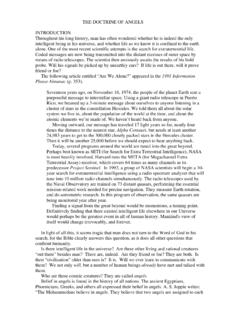Transcription of The Pagan SUN WORSHIP of ROMAN CATHOLICISM
1 The Pagan SUN WORSHIP of ROMAN CATHOLICISMIn the Vatican's St. Peter's basilica in Rome, there is a rather remarkable sculpture that probably goes mostly unnoticed by those who visit there. It is a part of a sculpture group by Gian Lorenzo Bernini decorating the tomb of Pope Alexander VII. At the four corners surrounding the kneeling Pope, are the four virtues, Charity, Prudence, Justice and Truth. Charity is on the front left side and "La Verita", which means "The Truth" is on the right front side of the overview scene from the video "Israel of the Alps"Copyright 1993 LLT Productions - Used by PermissionThe first thing you might notice is that "Truth" stands with her foot on a globe of the earth, symbolizing her power over the globe. Then looking closer you will see that she clutches in her arms the sun, probably symbolizing Truth's love for the light rather than darkness, and that the Truth will be revealed in time, by the light of by Scala/Art Resource, New YorkHistorically, Pagan Babylon worshipped the sun as a deity, and Pagan Rome also worshipped the invincible sun.
2 The ROMAN Catholic Church, with the assistance of Caesar's civil Sunday law (Constantine), transferred the Sabbath rest to the Sun Day, and commonly uses images and symbols of the sun. In the following articles we will examine the many Pagan sunburst images used by the Catholic Church in various forms of Testifies That Stars Depicted Pagan GodsAmos 5:26 But ye have borne the tabernacle of your Moloch and Chiun your images, the star of your god, which ye made to 7:43 Yea, ye took up the tabernacle of Moloch, and the star of your god Remphan, figures which ye made to WORSHIP them: and I will carry you away beyond Stones Give Their TestimonyOn the right is an artifact unearthed in the holy of holies of the Pagan temple in the Canaanite city of Hazor / Hatzor, in northern Israel, that dates to 1400 years before the time of Christ. It is described as follows: "a basalt offering table, pillar-shaped, with a carved symbol of the storm god Baal on its side.
3 That symbol was a circle with a cross in the center"Source: University of Illinois, Religious Studies, HazorThe restoration of the Sun-god's image and templeThe British MuseumAbove is a tablet from the early 9th century which depicts the Babylonian sun-god Shamash seated on the right, holding emblems of his authority, a staff and ring, and the king with two attendants on the left. In the center, on an altar, is a large 4-point sun image, with additional small wavy rays between the points. In Hebrew, the word for sun is:8121. shemesh, sheh'-mesh; from an unused root mean. to be brilliant; the sun; by impl. the east; fig. a ray, (arch.) a notched battlement:-- + east side (-ward), sun ([rising]), + west (-ward), window. See also H1053 in Strong's Hebrew diagram from Ceremonial for the use of the Catholic Churches in the United States of America, Ninth Edition, revised by Rev. W. Carroll Milholland, , published by H.
4 L. Kilner & Co., above diagram of the Catholic altar shows the same general Babylonian sun symbol. In the photo below, behind Pope John Paul II, on the front of the altar of St. Peter's Basilica, you see a tapestry with a sunburst design nearly identical to the Pagan sun-god symbol of Baal / Shamash. This tapestry is called the altar frontal, antipendium (antependium), or pallium : christmas Eve Mass at the VaticanCopyright 1996, NBC for BaalAbove: Pope John Paul II celebrates Pentecost, June 3rd 2001 Detail of a Photo Copyright by "L'Osservatore Romano" Photographic ServiceBelow: christmas Eve Mass at the VaticanCopyright 2000, NBC of Babylonian sun-god ShamashThe Pope conducting Midnight Mass on the stepsof St. Peter's Basilica on christmas Eve of on the left is a picture from the coronation of Pope Pius XI in 1922. On the tapestry hung from the balcony, there are three symbols of Baal / Shamash evident. On the right is Pope John XXIII waving to the crowd in St.
5 Peter's square from above another similar banner, after an Urbi Et Orbi 1922 by UnderwoodPhoto by Dmitri KesselBelow on the left is a similar photo of John Paul II, making his first public appearance as Pope, in by Fabian / Sygma Above on the right is a photo from early in the papacy of John Paul II, and the symbol of Baal / Shamash appears on the front of his fish head shaped mitre. Note also the small black cross on his shoulder (compare below), on what is called a Pallium:The modern pallium is a circular band about two inches wide, worn about the neck, breast, and shoulders, and having two pendants, one hanging down in front and one behind.. The ornamentation of the pallium consists of six small black crosses -- one each on the breast and back, one on each shoulder, and one on each on the left is a Neo-Assyrian standing stone (stele/stela) dating from about 824-811 , which depicts King Shamshi-Adad V. In particular, note the necklace the King is wearing.
6 On it is what is called a Cross Patt e or Cross Form e. Twenty-eight hundred years ago that shape was symbolic of Pagan sun WORSHIP (click on the image for a closer look). Stela of Shamshi-Adad VThe British MuseumPope John Paul II wearing the PalliumToday the Pope wears a similar symbol around his neck, on the Pallium, which the Pope also confers on selected bishops as an ornamental token of his favor, and it is also worn by archbishops and patriarchs as a symbol of their authority as a metropolitan, derived from unity with the Pope. Note also, that beneath the Pope's Pallium there is an "x" / diagonal cross, which mimics the diagonal bands below the Cross Patt e worn by the Pagan king. The Pope also has a ring and staff of authority, remarkably similar to the depiction of the sun god Shamash on the Babylonian tablet shown of King Ashur-nasir-pal IIThe British MuseumJohn XXIII Pontifex MaximusPhoto by Felici, RomaNote the lower hand of King Ashur-nasir-pal II in the above stele.
7 On the wrist is the sunburst symbol. On the right, the Pagan sunburst is on the glove of Pope John XXIII. (click on the image for a closer look)The depictions of the Pagan kings on the ancient standing stones above, show a strip of cloth (lappet) hanging from the rear of the headgear. These lappets are also present on the papal mitre and tiara, shown at left, and partially visible in the photos of popes DEL CONCILIO: CITTA DEL VATICANO: 1966 Press Office of the Ecumenical from the Archdiocese of Toronto symbols of Baal and Shamash worn by a Catholic the left is a medallion from the Vatican pavilion of the 1988 World Expo, which depicts what is called a Monstrance, used to display a consecrated host. It bears a remarkable similarity to the symbol of Baal / Shamash. At left are two examples of ciborium, in which are kept the Eucharistic wafer hosts of the Catholic Mass. The one on the left uses the Cross Patt e as a handle on top, and the other uses the four point cross within a circle, the ancient symbols of Shamash and the left is a Vatican 100 Lire gold coin.
8 Note the symbol of Baal, found in Hazor, is behind the head of the figure supposed to be that of you see the symbol of Baal used in artwork representing the Year of the Eucharist that appeared on the cover of the November 10, 2004 edition of L'Osservatore on the right you see the sunburst image on the underside of the canopy of Bernini's Baldacchino, the large canopy-like monument in St. Peter's Cathedral, directly over the main altar of St. Peter's, and the alleged tomb of St. Peter. The dove in front of the sunburst is supposed to be symbolic of the Holy Spirit. Note the shape of the sun rays. They are essentially identical to that of the Pagan sun symbol worn by Assyrian kings over 800 years before the time of christmas Eve Mass at St. Peter'sCopyright 1996, NBC Babylonian Sun god Shamash is also represented by a winged solar : Stela from the Temple of Marduk in BaldacchinoFrom a photo by Scala/Art Resource, New YorkBernini also put Pagan sun images on the top of each of the columns of his Baldacchino, which stands above the altar of St.
9 Peter's. (The sun image and 3 bumble bees are symbolic of the Barberini family and Pope Urban VIII).Here on the left is essentially the same image as found in Bernini's La Verita and Baldacchino, but this is the face of the Pagan Greek sun god Apollo, on the temple of Apollo, in the Pergamon museum in Berlin!Picture of the sun god the book "The New Illustrated Great Controversy"Copyright LLT Productions - Used by PermissionCatholicism has clearly adopted the sun symbolism of the ancient pagans!THE Pagan SUN WHEEL, THE OBELISK AND BAALA bove is a ROMAN coin from the 3rd century (Probus, 276-282) which on the reverse depicts the Pagan sun god driving a chariot drawn by four horses (Sol in Quadriga). The inscription reads SOLI INVICTO - The Invincible Sun.] At right is a similar mosaic found in the Vatican grottoes under St. Peter's Basilica, on the vaulted ceiling of the tomb of the Julii. It depicts Christ as the sun-god Helios / Sol riding in his chariot, and is dated to the 3rd century left is a Pagan sun wheel in the temple at Kararak India, which is associated with occultism and astrology.
10 It resembles a chariot wheel doesn't it?Note the following verse-2 Ki 23:11 And he took away the horses that the kings of Judah had given to the sun, at the entering in of the house of the LORD, by the chamber of Nathanmelech the chamberlain, which was in the suburbs, and burned the chariots of the sun with the book"The New Illustrated Great Controversy"Copyright LLT ProductionsUsed by PermissionWhen Israel apostatized, they made chariots dedicated to the sun god, who it was thought, traveled across the sky in a great chariot. Hence the origin of the sun Symbols of Baal, Ishtar and ShamashBelow is an artifact unearthed in the holy of holies of the Pagan temple in the Canaanite city of Hatzor / Hazor, in northern Israel. It is described as follows:"Of special interest is a square basalt altar for burning incense. On one of its sides, a circle with a cross in the center the divine symbol of the Canaanite storm god is carved in low relief.






